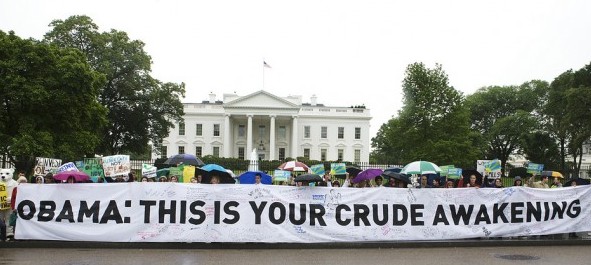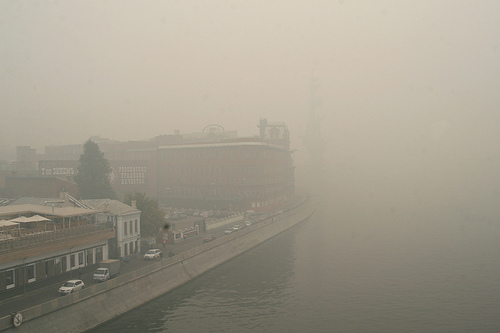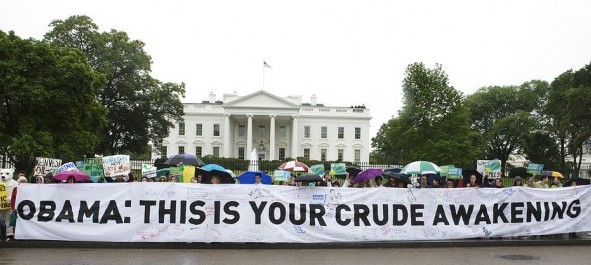 Activists send the White House a message.Photo: 350.orgRemember that $20 billion escrow account that BP is supposed to create to cover damages in the Gulf of Mexico? You know, the account that one Republican called a “slush fund” until he was told it made him look too chummy with a company that had dumped 4.1 million barrels of oil into the Gulf, so then he got all humble and sorry, except not really? Yeah, that one.
Activists send the White House a message.Photo: 350.orgRemember that $20 billion escrow account that BP is supposed to create to cover damages in the Gulf of Mexico? You know, the account that one Republican called a “slush fund” until he was told it made him look too chummy with a company that had dumped 4.1 million barrels of oil into the Gulf, so then he got all humble and sorry, except not really? Yeah, that one.
Well, the same account is raising hackles again, only this time with enviros.
Take a drill pill: As Monica Langley explains in The Wall Street Journal, the White House is considering an arrangement for the fund that would allow BP to use revenue it generates through production in the Gulf as future collateral. Which seems kind of crazy to green groups, since the feds would then have a vested interest in BP ramping up its drilling in the region. Says Beth Lowell of Oceana, “It is outlandish that we would encourage them to do the same thing that got them into this mess in the first place.”
Tyson Slocum, director of Public Citizen’s Energy Program, has fired off a letter to President Barack Obama blasting the idea:
It ensures that BP maintains a robust presence in offshore oil drilling despite indications that BP’s management of such operations has placed workers and the environment at risk. BP’s management problems are well-known and deep. The company has the worst environmental and worker safety record in the business. But the administration might be less likely to address those problems if it means the company can’t continue its profitable business-as-usual style.
The elephant in the plume: Scientists are just starting to analyze what’s been described as a huge chemistry experiment in the Gulf, and a lot of them just can’t believe you can dump that much oil and dispersant without doing some serious damage to sea life. Julia Whitty, reporting for Mother Jones, lays out a grim scenario, focusing on “the mysterious movements of a vast community of organisms known as the deep scattering layer, or DSL … layers of living creatures hiding on the cusp between perpetual twilight and darkness”:
Some early observations of the effects of the Gulf catastrophe suggest the daily vertical migrations of the animals of the deep scattering layer may be blocked when they encounter plumes of oil and contaminants. If so, then trapped below a plume, the DSL fish and invertebrates would be unable to access their prey. Trapped above, they would be unable to escape their predators. Trapped within, they would probably die — and in their deaths, poison those who eat them. For the ocean, any loss of productivity in the deep scattering layer would be the biggest cataclysm of all — impoverishing the surface waters, depleting the coasts, cascading across the boundaries between ocean and land to denude both natural and human economies.
It hasn’t helped that federal agencies like NOAA came down on their scientists when they were thought to be talking too much. Craig Pittman of the St. Petersburg Times reports that when researchers first started referring to huge, underwater plumes of oil, their bosses were less than thrilled.
No more BFF with EPA: Meanwhile, some enviros are unhappy with the Obama administration on another front. With climate legislation dead, the EPA is the only sheriff in town when it comes to policing greenhouse gases; the agency is planning to start implementing greenhouse-gas emission standards in January. But the Center for Biological Diversity says the agency is already backsliding because it plans to initially limit its enforcement to plants that emit high levels of greenhouse gases. Kate Sheppard has the story at Mother Jones.
Believe it. Or not: How does the public feel about all this? Nothing like a few polls to give you a clear picture of America’s twisted psyche on climate change.
First there’s one from Jon Krosnick at Stanford. It surveyed people in three states — Florida, Maine, and Massachusetts — and found that roughly 80 percent of them believe global warming is happening, and about three-quarters think it’s being caused by “things people do.”
Then you have another one from Shelton Group. It surveyed 1,098 consumers who occasionally buy green products and asked the climate skeptics among them what it would take to convince them that climate change is real and caused by humans. About 15 percent of them said they would start to come around if the polar ice cap melted, but only 3 percent said they would change their minds if Nebraska became a desert, reports Ariel Schwartz in Fast Company.
Cue the tumbleweed.




